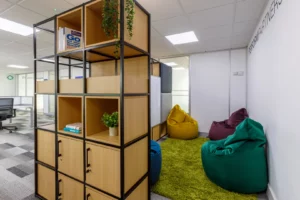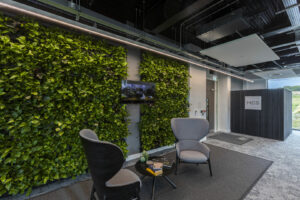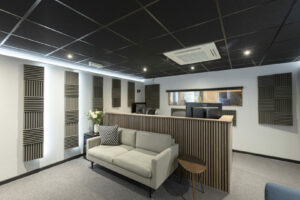In today’s business landscape, fostering an inclusive work environment that benefits employees is vital. At EDB our design team specialises in crafting office spaces that meet the diverse needs of your workforce, helping them to achieve their full potential.
It is estimated that 1 in 7 people in the UK are neurodiverse, meaning that their brain functions, learns and processes information differently from what is usually considered by society as ‘typical’. Employing neurodivergent individuals can enhance the workplace in many ways, by introducing different perspectives and approaches to problem-solving and tasks. This can then positively impact creativity, innovation and new insights. Therefore, if your business isn’t catering to support those who are neurodivergent, there is a risk of missing out on a huge pool of talent.
As office fit out experts, we have seen an increasing demand for office designs that are tailored to meet the varying needs of a diverse workforce, support employee wellbeing and are adaptable for those who may struggle in a traditional workplace. While there isn’t a one-size-fits-all solution, here are some considerations we would recommend when designing an office to support neurodiversity.
The consultation phase for office design
Neurodiversity is an umbrella term used to describe the differences in the human brain and encompasses a spectrum of conditions including autism, OCD, ADHD and dyslexia. Within these diagnoses, there is a wide spectrum of needs, which is why the consultation phase is key to determining what designs could benefit your team and future employees.
Designing for a diverse workforce should be at the forefront when in consultation and then in the design phase. Environments must be crafted to support employees’ concentration, performance and overall wellbeing.
Our design team can meet a spectrum of preferences by creating a range of spaces within a workspace to achieve the desired outcome: that every person feels they can work effectively. Onboarding an office fit out expert is key for more nuanced requests like tailoring spaces for neurodiversity, as we have the experience and expertise to create offices that work for everyone’s individual needs.
Why inclusive office designs are so important
Recent studies have emphasised that employees tend to be more productive and satisfied when they have a variety of workspace types to choose from. Depending on the type of task they are engaged in, this is particularly common for those who are neurodivergent. Space can help to remove barriers, it can improve culture and attitudes, it can help remove stigmas and it can increase choice, enabling people to be successful.
Having different spaces with different purposes is key for businesses who want to improve their office design for neurodiversity. Some design features we recommend are open spaces for socialising and collaboration, booths or quiet private rooms for focused work and intense concentration, breakout areas to relax, and soundproof meeting rooms where personal conversations can be had in confidence.
Office layout is also key when designing for neurodiversity, as using visual and environmental cues such as plants can help to improve wayfinding in your office, instead of spaces that all look the same which can cause difficulty.
There are also features which can be added to these spaces to make them a more inclusive design, such as softer lighting to help with concentration, noise-cancelling headphones and comfortable or adjustable chairs, which is particularly important when working long hours at a desk.
We have recently noticed that more of our clients are now involving their teams in the design. Many business owners have realised that if they’re trying to get more people back in the offices, they need to include their employees so that they feel like they have some ownership over the office. This is also a perfect opportunity for those who are neurodivergent to vocalise what would benefit them so that they don’t feel excluded.
The importance of colours in office design for neurodiversity
Colour is a powerful communication tool and can influence mood and impact performance. But exposure to colour can also have a physical impact on us. Bright or full-intensity colours can overwhelm those who are neurodivergent and it can lead to a sensory overload.
At EDB, our design team have the knowledge and expertise to guide business owners on what are appropriate colours when designing for neurodiversity. Warm colours like orange can increase engagement along with keeping employees calm and relaxed.
Lighting is also important to consider when designing for neurodiversity, as harsh lighting can cause agitation, anxiety, and visual fatigue, potentially limiting the ability to engage with spaces and activities fully. Choosing warm, soft, LED lighting with adjustable settings is essential when designing for neurodiversity and can have a wider benefit to all staff.
Natural lighting is also important as it creates a homier atmosphere, allows employees to connect with nature and reduces eye strain. Opening up the shades or installing more windows will make your office a more productive workspace with the benefits of natural lighting.
How to reduce noise levels within the office
Excess noise can often add to a neurodivergent person’s already heightened levels of stress and anxiety. Acoustic design can help to reduce worry and tension by creating a calm and soothing environment.
Acoustic panels are an ideal feature to add to your office as they absorb sound waves, reducing the overall noise levels in the office environment. This helps create a more peaceful and comfortable atmosphere, promoting concentration and productivity among employees. Acoustic panels also help create private zones within open-plan layouts by reducing sound transmission between adjacent workstations or meeting areas. This enhances confidentiality and minimises distractions, allowing employees to focus on their tasks without interruptions.
When it comes to interior design and acoustics, soundproofing with carpet is also a well-known strategy. With their dense fibres and soft surface, carpets can absorb sound waves, reducing echo and noise in a room.

Designing an office for a diverse workforce
Having a diverse workplace encourages individuals to express their ideas freely and comfortably without fear of being judged or scrutinised, which is why it’s important to ensure that your office is tailored for those who are neurodivergent. Additionally, employees who are part of a diverse workplace tend to have better job satisfaction, promoting productivity, engagement, and staff retention.
These are only a few examples of recommendations we have when designing for neurodiversity, which is why it can benefit your business to employ an office fit out expert. If you are looking to create a more inclusive and diverse workspace, then get in touch with our team to find out more about how we can help.





